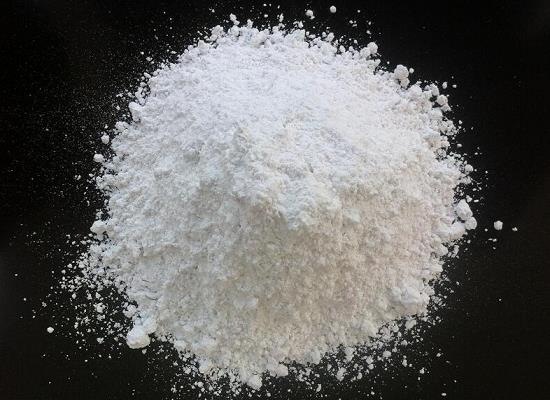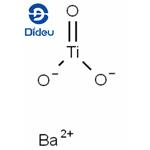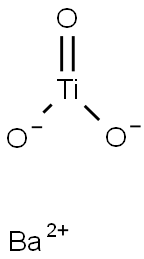Barium Titanate: Structure and Biological Properties
General Description
Barium titanate is a versatile ceramic material renowned for its ferroelectric properties and intricate perovskite structure, encompassing four distinct phases—cubic, tetragonal, orthorhombic, and rhombohedral. Its unique piezoelectric characteristics enable barium titanate to generate micro-electric currents, which significantly enhance calcium deposition at bone defect sites, facilitating bone regeneration. Additionally, barium titanate exhibits excellent biocompatibility, with studies showing no inflammatory responses at the implant-tissue interface, promoting successful integration with surrounding tissue. Research into composite coatings, including barium titanate with titanium dioxide, has further improved its bioactivity and corrosion resistance, highlighting its potential in biomedical applications, particularly in orthopedics.

Figure 1. Barium titanate
Structure
Barium titanate is a notable ceramic material known for its ferroelectric properties and distinctive perovskite structure. The structure of barium titanate is quite complex, displaying four distinct crystal phases: cubic, tetragonal, orthorhombic, and rhombohedral. At temperatures above 120°C, barium titanate adopts a cubic phase with a symmetric perovskite structure, where barium and oxygen ions form a face-centered cubic lattice, while titanium ions occupy the octahedral interstitial spaces. In this cubic phase, the barium titanate structure lacks polarization, hence exhibiting paraelectric behavior. As the temperature decreases below 120°C, the symmetry of the barium titanate structure breaks, leading to a tetragonal phase with net spontaneous polarization. Further cooling transitions the material to an orthorhombic phase between −5°C and −90°C and eventually to a rhombohedral phase at temperatures below −90°C. Each phase of barium titanate demonstrates unique distortions and polarization characteristics, which are crucial for its applications in various electronic devices. 1
Biological Properties
Introduction to the Biological Properties
Barium titanate is a widely studied piezoelectric ceramic known for its remarkable biological properties, particularly in the realm of bone regeneration. When used in medical applications, barium titanate can simulate the electrical stimuli produced by natural bone under stress. This unique property enables barium titanate to generate micro-electric currents at bone defect sites, significantly enhancing calcium salt deposition. Consequently, the application of barium titanate in implants not only improves bone healing but also modifies the development and morphology of bone tissue. As barium titanate interacts with the biological environment, it facilitates the shaping and reconstruction of tissues, thereby playing an essential role in bone repair. 1
Biocompatibility and Interfacial Integration
One of the most significant biological properties of barium titanate is its excellent biocompatibility. Numerous animal studies have confirmed that the nanoparticle form of barium titanate does not elicit foreign body reactions or inflammatory responses at the implant-tissue interface. This characteristic suggests that barium titanate possesses systemic non-toxicity, making it a suitable candidate for various biomedical applications. The ability of barium titanate to establish a robust interfacial bond with surrounding bone tissues is crucial for the success of implants, ensuring that they integrate effectively with the host environment. This property not only enhances the longevity of implants but also supports the regeneration processes necessary for restoring bone functionality. 1
Composite Coatings and Enhanced Properties
Research into barium titanate has led to the development of advanced coatings that improve not only biocompatibility but also bioactivity and corrosion resistance. For instance, BaTiO3/TiO2 double-layer coatings demonstrate superior electroactive performance, which is beneficial for implants made from titanium or zirconium alloys. These composite materials exhibit a denser microstructure and improved grain size, contributing to enhanced corrosion resistance in biological settings. Furthermore, the addition of barium titanate to various implant coatings, such as those involving hydroxyapatite, has shown promising results in increasing the overall bioactivity of the materials. The ability of barium titanate-based coatings to form apatite on their surfaces after immersion in simulated body fluids underscores their potential to support biological tissue growth, indicating a promising direction for the future of barium titanate in orthopedic applications. 1
References:
[1] SABREEN WALEED IBRAHIM J H Thekra Ismael Hamad. Biological properties of polycaprolactone and barium titanate composite in biomedical applications.[J]. Science Progress, 2023, 106 4. DOI:10.1177/00368504231215942.Lastest Price from Barium titanate manufacturers

US $0.00-0.00/kg2025-12-13
- CAS:
- 12047-27-7
- Min. Order:
- 1kg
- Purity:
- 98%
- Supply Ability:
- 1000kg

US $7.00/kg2025-04-21
- CAS:
- 12047-27-7
- Min. Order:
- 1kg
- Purity:
- 0.99
- Supply Ability:
- 1000


